Effects of Air on the Intonation of Clarinet
How does temperature and air composition affect the pitch of the clarinet? While there are several factors impacting sound, the pitch of the instrument relies heavily on the inner air column's composition and temperature.
Ambient air
The first factor to mention is the temperature of the outside air. In contrast to the string instruments, where the warming of the instrument body leads to a lower pitch, the opposite tendency can be observed with the clarinet.
This is due to the acoustics of the instrument. When a note is played, it is not the body of the instrument that vibrates, but the column of air in the inner bore. When this column of air warms up, the speed of the sound and its resonant frequency increase in direct proportion.
The outside temperature affects both the temperature of the inner air column and the temperature of the clarinet, which in turn affects the inside temperature.
A study published in 1959 showed that a rise in outside temperature of 10 °C can increase the pitch of a clarinet by 0.09 semitones, i.e. 9 cents. [1]
However, a study by Balasubramanian & Kausel came to a slightly different conclusion. As shown in Fig. 10., with the increase in temperature from 21°C to 31°C, there is also an increase in pitch of almost 30 cents.
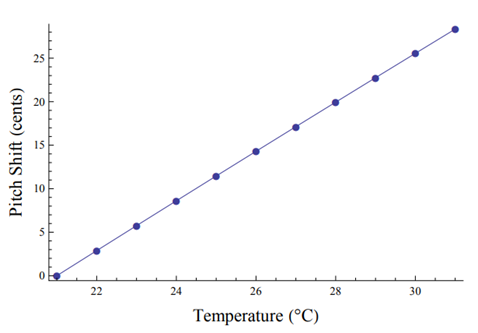
Fig 10: Pitch shift on temperature rise [2]
Another external parameter that affects pitch is the composition of the air, as the proportion of different gases and particles also affects the speed of sound. Denser air reduces the speed of sound, while less dense air favours the propagation of sound waves and thus increases the pitch.
The most important element in the composition of outdoor air that affects pitch is humidity. When this increases, the density of the air decreases, so that the pitch increases. Humidity depends very much on the temperature of the air. At higher temperatures, the air can absorb more water.
At 100% relative humidity, the speed of sound can increase by 0.35% compared to 0% humidity. The effect of humidity on the speed of sound can increase as the air pressure decreases, so that at 6000 metres above sea level the previous value of 0.35% can increase to 0.7%. An increase in temperature also increases the effect of humidity on the speed of sound, but the magnitude of this increase is negligible.[3]
Inhaled air
As shown in the figure below (Fig. 11), the exhaled air temperature of about 31°C (other sources speak of 33 to 35°C) [4] which is usually much warmer than the outside temperature and thus has a great influence on the intonation of the instrument.
When playing the clarinet, the exhaled air is constantly cooled or warmed by the temperature of the outside air and the temperature of the instrument body.
A common problem is uneven fluctuations in body temperature, which can lead to serious intonation problems. When the outside temperature differs from the temperature of the air blown into the clarinet, different parts of the instrument heat up or cool down at different rates during blowing.
In general, the lower parts of the instrument will tend to approach the outside temperature, while the parts closer to the mouthpiece will tend to absorb the temperature of the blown air.
This is because the lower part of the instrument is less able to absorb the blown air as it is expelled through the open sound holes.
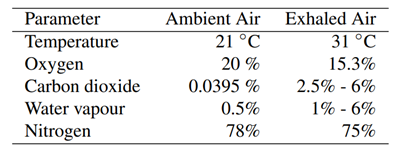
Fig 11: Air composition [5]
It is common practice among wind players to preheat the instrument, especially to blow in warm air and possibly to warm the body of the instrument by hand. This warms the instrument and cools the air column less at the moment of blowing, which allows for a less fluctuating pitch.
Preheating the instrument body from 20°C to 25°C can cause an intonation difference of +17 cents.[6]
In other words, an instrument that is not at the right temperature can lose a lot of intonation in a short time.
Although the temperature of the air blown into the instrument has a great influence on the pitch and plays an important role in warming and keeping the body of the instrument warm, the temperature of the air blown into the instrument varies very little during playing.
It can be concluded that when the outside temperature is warmer, it is easier to correct the intonation of the instrument because the difference between the outside temperature and the temperature of the exhaled air is relatively small.
As a result, the temperature of the instrument body also remains more stable, which contributes to a more stable intonation.
The relative humidity of the exhaled air is usually higher than the humidity in the outside air, which also contributes to the change in pitch.
According to a study by Berry in 1914, this relative humidity in the exhaled air is about 78%. [7], which is strongly influenced by the air temperature, among other things. [8]
However, as the figure below shows, the effect of a 3% increase in water vapour content in the air on pitch is almost negligible at only 0.3 cents (see Fig. 12.).

Fig 12: Pitch shift on H2O [9]
During inhalation and exhalation, the amount of nitrogen taken in and released is equal. The oxygen (O2) is released from the lungs into the bloodstream and consumed, and the carbon dioxide (CO2) is returned to the lungs and exhaled.[10]
This is of great importance for wind instruments because the ratio of O2 to CO2 is constantly changing when blowing. From the moment the instrument is blown, the carbon dioxide content constantly increases. The air blown out becomes denser and the pitch steadily decreases (see fig. 13).
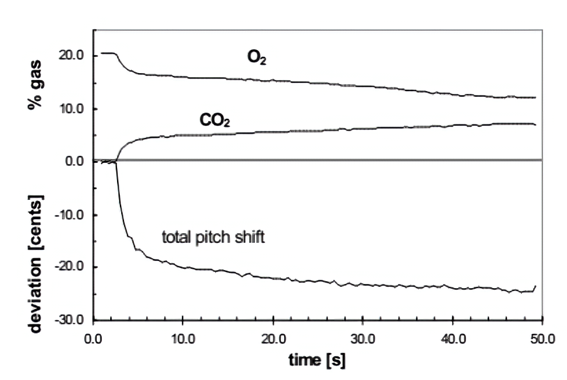
Fig 13: CO2 and O2 [11]
The following figure (see Fig. 14) shows the change in CO2 content during the blowing of four different tones. The exhaled CO2 content is about 3% at the time of the beginning of the tone and reaches about 8% after 50 seconds. This corresponds to a CO2 rate increase of about 3 - 4.8% per minute, which can lead to lower fundemental frequency (up to 20 - 25 cents).[12]
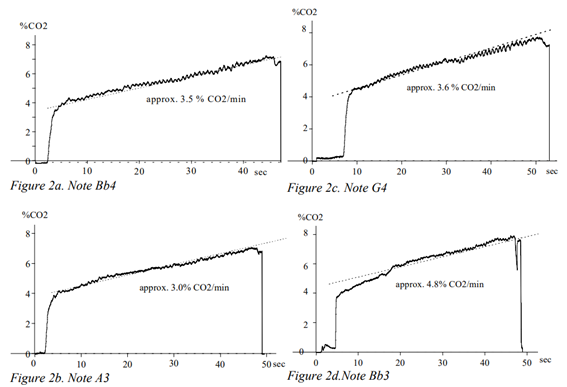
Fig 14:Change of CO2 by time[13]
An increased carbon dioxide content has a significant effect on the intonation of instruments with a lower air requirement (including the Bb clarinet). In contrast, the effect of CO2 on the intonation of bass clarinets is less significant, as the amount of air required is greater and therefore the duration of blowing is shorter.
Furthermore, the mixing of external air and air blown into the instrument needs to be investigated in more detail, as an increased internal CO2 content is also influenced by the composition of the air entering the instrument. This is not captured by the measurements shown above.
In Fig. 15. we see how the pitch changes over time. The pitch rises suddenly after inhalation and then falls steadily. This trend can also be observed while circular breathing.
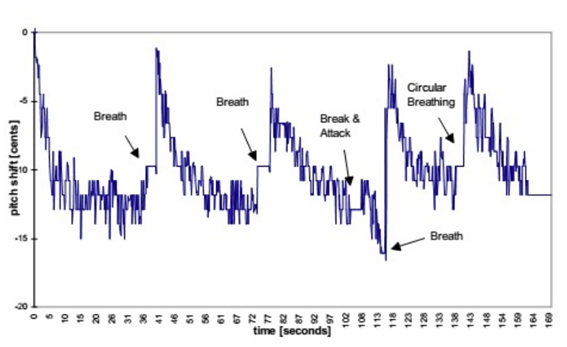
Fig 15: Measured variation in pitch during continuous play [14]
In a longer passage, breathing can be important not only to be able to play through the passage, but also to provide purity. Another example is that it may be worthwhile to begin a phrase with a 'worn' air rather than a fresh one. For this, it is important to know the basic intonation variations of one's own instrument.
[1] Young, Robert W. & Webster, John C. Some Factors Affecting the Intonation of a Clarinet. in: The Journal of the Acoustical Society of America 31, 6. (1959), S. 839.
[2] Balasubramanian, Saranya & Kausel, Wilfried. Pitch Shifts in Wind Instruments due to Changes in Air Composition. in: Proceedings of the Third Vienna Talk on Music Acoustics (2015), S. 18.
[3] Brennan, John. How Does Humidity Affect Speed of Sound?. 2018. verfügbar auf: https://sciencing.com/humidity-affect-speed-sound-22777.html (abgerufen am: 22.09.2021).
[4] Mirela-Adelaida, Anghel & Iacobescu, Fănel. The Influence of Temperature and CO2 in Exhaled Breath. in: International Congress of Metrology, (2013), S. 10012.
[5] Balasubramanian, Saranya & Kausel, Wilfried. Pitch Shifts in Wind Instruments due to Changes in Air Composition. in: Proceedings of the Third Vienna Talk on Music Acoustics (2015), S. 15.
[6] Fuks, Leonardo. Prediction of Pitch Effects from Measured CO2 Content Variations in Wind Instrument Playing. in: Division of Speech, Music and Hearing 37, 4. (1996), S. 41.
[7] Berry, Elmer. Relative Humidity of Expired Air. in: American Physical Education Review 19, 6. (1914), S. 452-454.
[8] Turner, Nina & Parker, John & Hudnall, Judy. The Effect of Dry and Humid Hot Air Inhalation on Expired Relative Humidity During Exercise. in: American Industrial Hygiene Association Journal 53, 4. (1992), S. 256-260.
[9] Balasubramanian, Saranya & Kausel, Wilfried. Pitch Shifts in Wind Instruments due to Changes in Air Composition. in: Proceedings of the Third Vienna Talk on Music Acoustics (2015), S. 18.
[10] Miller, Gerald. Biomedical Transport Processes. in: Introduction to biomedical engineering (2012), Academic Press, S. 942.
[11] Balasubramanian, Saranya & Kausel, Wilfried. Pitch Shifts in Wind Instruments due to Changes in Air Composition. in: Proceedings of the Third Vienna Talk on Music Acoustics (2015), S. 18.
[12] Fuks, Leonardo. Prediction of Pitch Effects from Measured CO2 Content Variations in Wind Instrument Playing. in: Division of Speech, Music and Hearing 37, 4. (1996), S. 40.
[13] Fuks, Leonardo. Prediction of Pitch Effects from Measured CO2 Content Variations in Wind Instrument Playing. in: Division of Speech, Music and Hearing 37, 4. (1996), S. 40.
[14] Balasubramanian, Saranya & Kausel, Wilfried. Pitch Shifts in Wind Instruments due to Changes in Air Composition. in: Proceedings of the Third Vienna Talk on Music Acoustics (2015), S. 18.
Do you like this article?
Thanks for your feedback
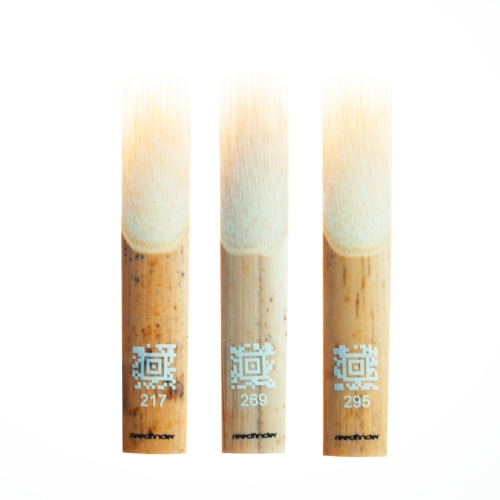
World’s #1
Reed Recommendation System
We believe every musician deserves a reed that matches their unique style and sound. Each reed is selected with cutting-edge AI and machine learning based on your playing feedback.
Should You Try the Benz-Tec Digital Reed Tester? I've tested it for you!
Check out the best clarinet jokes to brighten your day!
Struggling to hit the right notes? Your instrument might be the culprit! Learn how to fix intonation problems and stay in-tune.
Unleash the full potential of your clarinet with our exclusive care guide. Elevate your playing with tips that ensure your instrument remains in perfect condition.
Here are the top 7 picks of best applications to download for classical musicians. Tuners, Metronomes and more.
Buffet Crampon's latest innovation: the Prodige Pocket Clarinet. Is it really the best instrument for young clarinetists? Check out our review!
Discover the best clarinet mouthpieces! Check out our reviews and recommendations for Bb and Bass clarinet.
Learn the technique of circular breathing. Expert guide with step-by-step instructions and troubleshooting tips for continous breathing.
A groundbreaking innovation of Buffet Carmpon: Clarimate. This is our honest review about its innovative features and real-world performance. Is it for you?
Discover the role of clarinet ligatures in achieving optimal sound and control. Explore various ligature types, materials, and techniques to enhance your clarinet playing experience.


